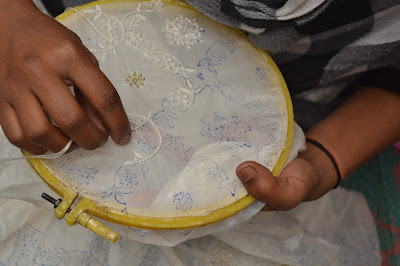CHIKANKARI-Sheer elegance
Chikankari , the art of
whitework embroidery developed during the Mughal Period bestowed the small town
Lucknow with international acclaim for its incomparable and intricate work that
emitted royalty appealing people world
over .Apart from Lucknow’s magnificent Imambaras and grand Mosques which beared
testimony to its rich cultural heritage, Chikankari rightfully placed itself
into that legacy . There are references
to Indian Chikan work as early as 3rd century BC by Megasthenes,
who mentioned the use of flowered muslins by Indians. Another tale also mentions how a traveler
taught Chikankari to a peasant in return of water to drink. However history also
reminisces the origin of chikankari by the female helpers of the Mughal
Emperors who would do subtle needlework in their leisure times on the Emperor’s
angrakha or cap.The name Chikan has
been derived from the Persian word Chakin or Chikeen meaning a cloth wrought
with needlework.
Unfortunately the irony lies in the
fact that with the rising demands of this textile , the versions of Chikankari
we find in recent times is just a mere adaptation of the real ones with
involvement of cheaper fabrics like poly cotton,terry cotton,rubia and polyester threads with loose stitches for
fast and cheap production that nowhere justifies the authenticity of the
fabric. Defeating the threat on this fabric is a name, Gaurang, whose tremendous
efforts on preserving its genuineness
and quality is to be accredited. The embroidery is created on his assortment of
rich fabrics like tussar, tussar-kota, muga, khadi etc involving the finest
stitches in intricate patterns and detailing. His signature style of infusing two rich
techniques and other smart incorporations give us a surprising wide platter of
variations neither compromising the tradition nor the contemporary appeal.
While his bold geometric patterns of diagonals, polkas etc were quite a huge
hit till recently, Gaurang’s efforts to continuously exhibit a different dimension
to the same textile art has now led him to style it with intricate detailing on
both geometric patterns and motifs like
kalkas, jaal,chadiya,buti jaal to name a few, sometimes accentuating them
with badla work and takes almost
triple the time compared to an easier pattern. The infusion of kalamkari with
chikankari on the same piece is a beauty to be adored and takes a time of
almost one and half years for completion.While the local chikankaris invests
only 2-3 designs or layouts on a single piece to save up on time and cost, Gaurang’s
versions uses almost 10-12 layouts to give us the best of it.
The technicality : The piece begins with the printing of pattern blocks usually made of shisham wood on the ground fabric and now imprints are also taken down from khakhas directly to create big Jaal layouts without repeat. The embroiderer then stitches the pattern, and the finished piece is carefully treated with a careful amount of bleach, soda, soap and acid and then washed mildly on rectangular wooden planks made of mango, babul or neem tree.
The technicality : The piece begins with the printing of pattern blocks usually made of shisham wood on the ground fabric and now imprints are also taken down from khakhas directly to create big Jaal layouts without repeat. The embroiderer then stitches the pattern, and the finished piece is carefully treated with a careful amount of bleach, soda, soap and acid and then washed mildly on rectangular wooden planks made of mango, babul or neem tree.
The patterns and effects created depends
on the types of stitches , the thickess of the needle and the number of threads
used in the embroidery. While the local versions use thicker needles, easier
stitches like bakhiya, tepchi etc,
polyester threads with higher counts,
Gaurang’s versions never compromise on any step which would otherwise
damage the quality of the fabric-be it the use of pure cotton 6-ply yarn for
the embroidery or the clean workmanship in the stitches.Some of the varieties
of stitches used include Jali,
Murri, Ghaas Patti, Dhaniya Patti, Fanda, Bakhiya, Keel, Kangan, Karan Phool,
Peshni, Balda, Kauri, Bijli, Tepchi, Hatkadi etc.
Little did we know that our journey through the small lanes
of a village near Lucknow adorned with multicolored whitewashed houses and
cattle farms , would lead us to a visual treat which has to be seen to feel.Magic
was being created by a bunch of giggling and smiling women of varied age groups
sitting together who greeted us with a sense of contentment. Their eye for
minute detailing, their enthusiasm to keep the textile art form alive in a
vibrant way was overwhelming. To what prevails generally of infrequent work and
bad payment terms which indirectly dampens an embroiderer’s spirit, Gaurang
accompanied by his master embroiderer has transformed the lifestyle of their
workers and the village as a whole with good pay, proper hierarchy,various
units with experienced instructors to hone the skills of newcomers ,
incorporation of smarter techniques to co-ordinate with them and hence can be considered
as a role model of women empowered industry which justifies his sincere vision
of reviving this textile art in the truest sense.


















No comments:
Post a Comment